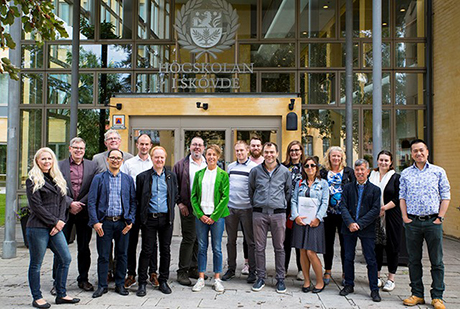The progression of sepsis, or blood poisoning, is very quick. A person's condition can become life threatening in just a few hours. Today, blood culture is the method used to diagnose sepsis, and it normally takes around 48 hours to get the results. But by using new instruments for diagnosing, the goal of the the EU-project SMARTDIAGNOS is to reduce that time significantly. And thereby save lives. The project participants have met in Skövde.

Researchers in the EUH2020-project SMARTDIAGNOS, enjoying the 6th partner meeting at the University of Skövde.
The partner meeting in Skövde is the 6th meeting in the project, which is scheduled to be completed early 2020. The group of participants is made up of researchers and several companies from the medical technology sector throughout Europe, and the University of Skövde, the Department of Infectious Diseases at Skaraborg Hospital and the clinical lab, Unilabs AB, at Skaraborg Hospital. They all work together in improving the diagnostics of sepsis. Today, diagnosing can be a challenge. And the stakes are high.
Reducing the use of antibiotics
– The symptoms for sepsis are vague, which can make it difficult to discern sepsis from other conditions such as food poisoning or the flu. But for good reasons, considering the risks involved, the patient usually receives antibiotics immediately, says Anna-Karin Pernestig, sub-project manager and Senior Lecturer in Molecular Biology at the University of Skövde. Diana Tilevik, also a sub-project manager and Senior Lecturer in Systems Biology at University of Skövde, adds:
– If we can find a quicker way for the healthcare staff to diagnose the condition, we can reduce the "unnecessary" use of antibiotics for patients who do not have sepsis. This is a long-term goal for the project.
Days of waiting reduce to 4 hours
In order to reach that goal, new technology and methods are required. In the scope of the project, new instruments are being developed that will eventually be available in emergency units and laboratories. The goal is to reduce the current wait time for analyses of up to 72 hours down to 4.
– For every hour of waiting time, the risk of death increases, so time is a crucial factor to focus on.
Early next year the instrument prototypes go into a testing phase at three laboratories in three countries: Unilabs Skövde (Sweden); Prague (Czech Republic); and Krems (Austria). Helena Enroth, Adjuct Professor in Molecular Biology at the University of Skövde and Molecular Biologist at Unilabs AB talks about the future of the project:
– Around 2020, when the project is finalized, we will have accomplished a great deal towards our final goal.

This project has received funding from the European Union’s Horizon 2020 research and innovation programme under grant agreement No 687697.